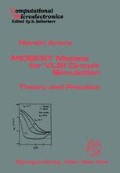Abstract
In integrated circuit technology, the final dimensions of all structures (transistors, capacitors, interconnecting wires, etc.) on finished wafers usually differ from their drawn (intended) dimensions due to several processing effects such as lateral expansion of local oxidation, imperfect etching, mask alignment tolerances, etc. It is observed, for example, in a 2 μm CMOS process, a polysilicon line drawn to be 2μm could be any where between 1.3–1.8 μm. Similarly, a 4 μm drawn metal line would turn out to be anywhere between 3.2–4.2 μm. Further, since transistor dimensions are determined by the width of the crossing polysilicon and by the lateral diffusion of the source and drain, transistor width to length ratio (W m /L m) can vary appreciably from the intended value. In addition to the line-width variations, there are many other process related variations such as changes in oxide thickness, sheet resistance, threshold voltage, etc., which result in the spread in device performance. Clearly, device parameters are subject to statistical variations due to manufacturing process disturbances. These variations affect the circuit performance dramatically. For example, changes in threshold voltage due to process variations will result in changes in transistor characteristics, which in turn affect DRAM access time and refresh rate, clock speed, etc., in digital circuits and op-amp gain in analog circuits. In the worst case the circuits might cease to function.
Access this chapter
Tax calculation will be finalised at checkout
Purchases are for personal use only
Preview
Unable to display preview. Download preview PDF.
References
R. Spence and R. S. Soin, Tolerance Design of Electronic circuits, Addison-Wesley Publishing Co., Reading, MA, 1988.
P. Yang and P. Chatterjee, ’statistical modeling of small geometry MOSFET, IEEE-IEDM82, Tech. Digest, pp. 286–289 (1982).
P. Cox, P. Yang, S. S. Mahant-Shetti, and P. Chatterjee, ’statistical modeling for efficient parametric yield estimation of MOS VLSI circuits’, IEEE Trans. Electron Devices, ED-32, pp. 471–478 (1985).
N. Herr and J. J. Barnes, ’statistical circuit simulation modeling of CMOS VLSI’, IEEE Trans. Computer Aided Design, CAD-5, pp. 15–22 (1986).
J. P. Spoto, W. T. Coston, and C. P. Hernandez, ’statistical integrated circuit design and characterization’, IEEE Trans. Computer Aided Design, CAD-5, pp. 91–103 (1986).
T. K. Yu, S. M. Kang, I. N. Hajj, and T. N. Trick, ’statistical performance modeling and parametric yield estimation of MOS VLSI’, IEEE Trans. Computer Aided Design, CAD-6, pp. 1013–1022 (1987).
P. Tuohy, A. Gribben, A. J. Walton, and J. M. Robertson, ‘Realistic worst-case parameters for circuit simulation’, IEEE Proa, 134, Pt. I, pp. 137–140 (1987).
S. Inohira, T. Shinmi, M. Nagata, T. Toyabe, and K. Iida, ‘A statistical model including parameter matching for analog integrated circuits simulation,’IEEE Trans. Computer Aided Design, CAD-4, pp. 621–628 (1985).
M. Pelgrom, A. Duinmaijer, and A. Welbers, ‘Matching properties of MOS transistor’, IEEE J. Solid-State Circuits, 24, pp. 1433–1439 (1989).
C. Michael and M. Ismail, ’statistical modeling of device mismatch for analog MOS integrated circuits’, IEEE J. Solid-State Circuits, 27, pp. 154–166 (1992).
L. A. Glasser and D. W. Doubberpuhl, The Design and Analysis of VLSI Circuits, Addison-Wesley Publishing Co., Reading, MA, 1985.
W. Maly and A. J. Strojwas, ’statistical simulation of the IC manufacturing process’, IEEE Trans, on Computer Aided Design, CAD-1, pp. 120–131 (1982).
S. R. Nassif, A. J. Strojwas, and S. W. Director, ‘FABRICHSII: A statistical based IC fabrication process simulator,’IEEE Trans, on Computer Aided Design, CAD-3, pp. 40–46 (1984). Also see Report (Feb. 1990) on FABRICS II: ‘A statistical simulator of the IC manufacturing process’, Department of Electrical Engineering, Carnegie-Mellon University, Pittsburgh, PA, 15213.
S. R. Nassif, A. J. Strojwas, and S. W. Director, ‘A methodology for worst-case analysis of integrated circuits’, IEEE Trans, on Computer Aided Design, CAD-5, pp. 104–113 (1986).
D. G. Rees, ‘Foundations of Statistics’ ,Chapman and Hall, New York, 1987.
R. E. Walpole and R. H. Myers, Probability and Statistics for Engineers and Scientists, McGraw Hill, New York, 1976.
C. W. Helstrom, Probability and Stochastic Processes for Engineers ,Macmillan Publishing Company, New York, 1984.
N. D. Arora and L. M. Richardson, ‘MOSFET modeling for circuit simulation’in Advanced MOS Device Physics (N. G. Einspruch and G. Gildenblat, eds.), VLSI Electronics: Microstructure Science, Vol. 18, pp. 236–276, Academic Press Inc., New York, 1989.
V. Bernett and T. Lewis, Outliers in Statistical Data ,John Wiley &Sons, New York, 1978.
J. A. Power, A. Mathewson, and W. A. Lane, ‘MOSFET statistical parameter extraction using multivariate statistics’, 1991 Int. Conf. Microelectronics Test Structures, 4, pp. 209–214 (1991).
M. Bolt, M. Rocchi, and J. Engel, ‘Realistic statistical worst-case simulations of VLSI circuits’, IEEE Trans. Semicond. Manuf., 4, pp. 193–198 (1991).
D. A. Divekar, R. W. Dutton, and W. J. McCalla, ‘Experimental study of Gummel-Poon Model parameter correlations for bipolar junction transistors’, IEEE Journal of Solid-State Circuits, SC-12, pp. 552–559 (1977).
A. A. Afifi and V. Clark, Computer-Aided Multivariate Analysis ,Lifetime Learning Publications, Belmont, CA, 1984.
J. Vlach and K. Singhal, Computer Methods for Circuit Analysis and Design ,Van Nostrand Rienhold Company, New York, 1983.
D. F. Morrison, Multivariate Statistical Methods ,McGraw-Hill Book Company, New York, 1976.
R. A. Johnson and D. W. Wichern, Applied Multivariate Statistical Analysis ,Prentice-Hall Inc., Englewood Cliffs, New Jersey, 1982.
M. E. Johnson, Multivariate Statistical Simulation ,John Wiley &Sons, New York, 1987 (P-52).
Author information
Authors and Affiliations
Rights and permissions
Copyright information
© 1993 Springer-Verlag/Wien
About this chapter
Cite this chapter
Arora, N. (1993). Statistical Modeling and Worst-Case Design Parameters. In: MOSFET Models for VLSI Circuit Simulation. Computational Microelectronics. Springer, Vienna. https://doi.org/10.1007/978-3-7091-9247-4_12
Download citation
DOI: https://doi.org/10.1007/978-3-7091-9247-4_12
Publisher Name: Springer, Vienna
Print ISBN: 978-3-7091-9249-8
Online ISBN: 978-3-7091-9247-4
eBook Packages: Springer Book Archive

